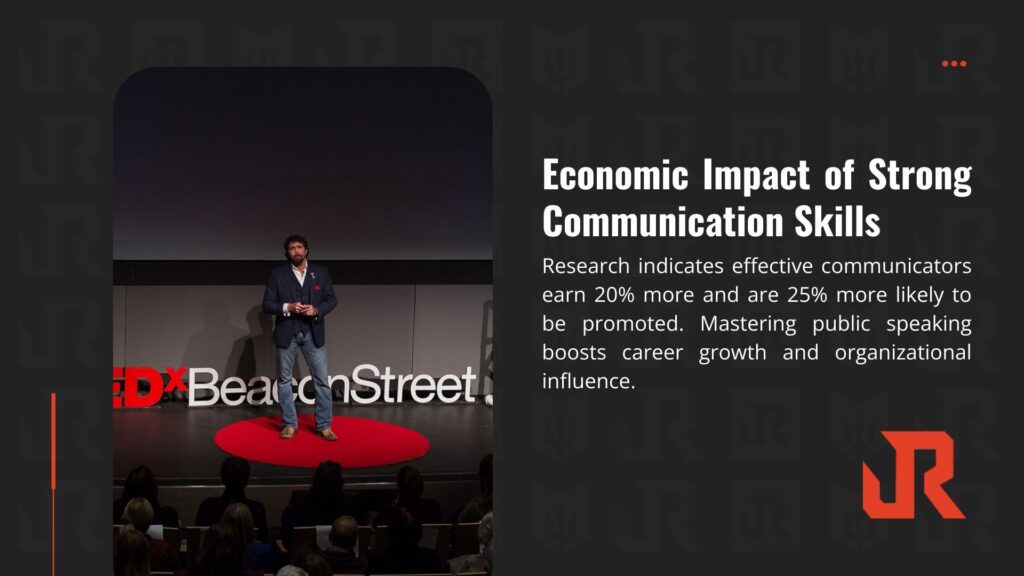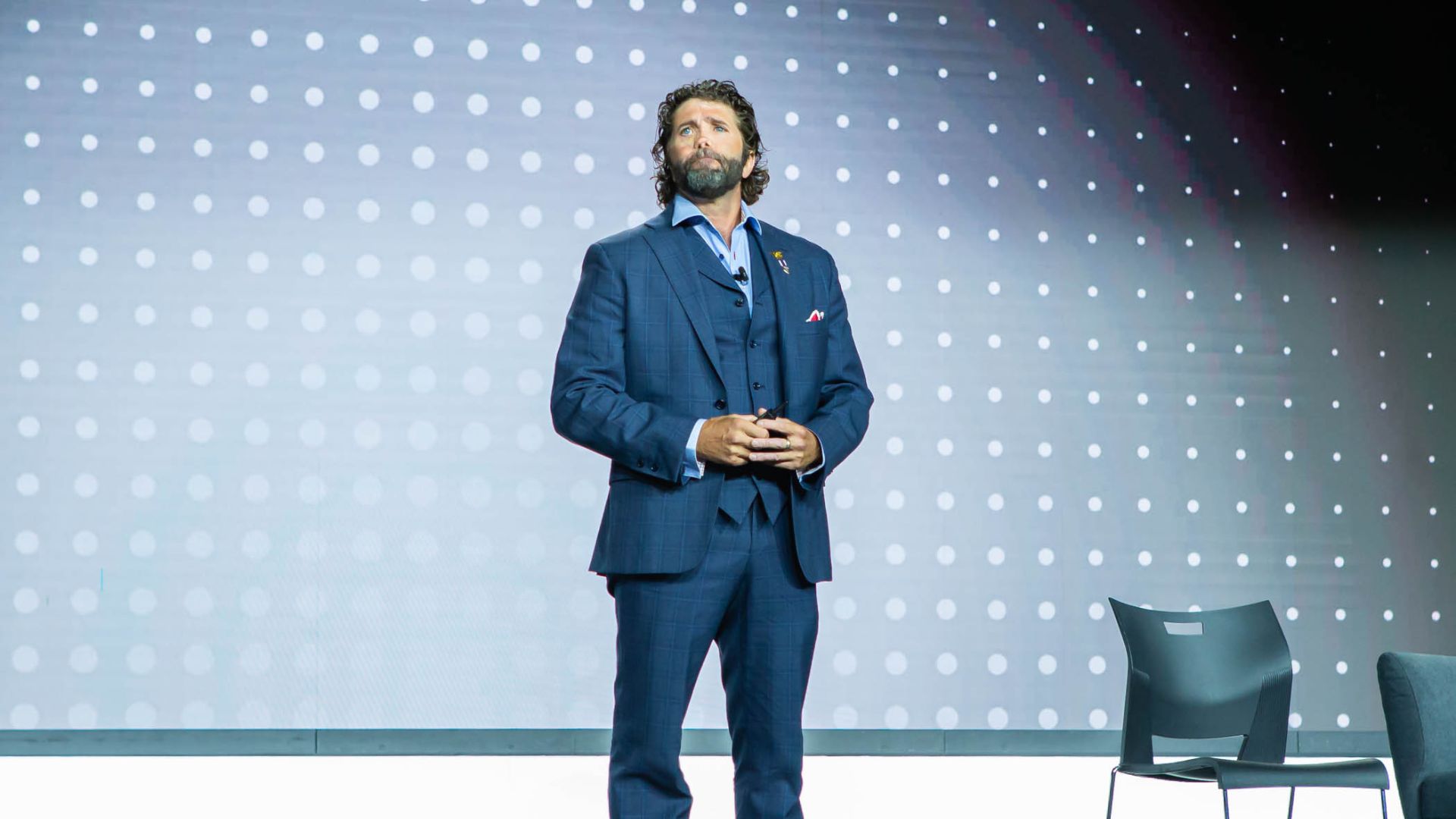I’ll never forget the first time I had to speak to a room full of civilians after my injury. There I was, a Navy SEAL who had led men into combat, faced down enemy fire, and survived an ambush that nearly killed me, and I was terrified of talking to 200 business executives in suits.
The irony wasn’t lost on me. I could handle a firefight in Iraq, but public speaking had me breaking into a cold sweat. My heart was pounding harder than it did during my first SEAL training exercise. That’s when I realized that most people approach public speaking all wrong.
75% of people are absolutely terrified of it. You’re not broken. You’re not weak. You’re human. Your brain can’t tell the difference between standing in front of a hostile audience and facing down a real physical threat. The same fight-or-flight response kicks in whether you’re being shot at or presenting quarterly reports.
But what separates those who overcome from those who stay stuck on the X is that they understand that confidence doesn’t come from positive thinking or pretending you’re not scared. Confidence comes from competence. And competence comes from preparation.
The Reality of Public Speaking Fear
Let me paint you a picture of what fear of public speaking really costs you. It’s not just about avoiding the company presentation or declining that speaking opportunity. This fear can cut your earning potential by 10% and reduce your chances of promotion by 15%. If you can’t communicate your ideas effectively, you’re essentially handicapping your own success.
I learned this lesson the hard way during my recovery at Bethesda Naval Hospital. When I hung that famous sign on my door—”If you are coming into this room with sorrow or to feel sorry for my wounds, go elsewhere”. I was communicating with absolute clarity and purpose. That sign was a strategic communication designed to shape my environment and control my recovery narrative.
That’s what effective public speaking really is. Taking control of the narrative and leading your audience where you want them to go.
My REACT Methodology Applied to Public Speaking
Every mission requires intel, planning, rehearsal, and execution. Public speaking is no different. You wouldn’t go into combat unprepared, so why would you step on stage without the same level of tactical preparation?
Here’s how I apply my REACT Methodology to conquering the podium:
- Recognize Your Reality: Stop telling yourself you’re “just not a speaker.” The reality is that speaking is a learnable skill. Every great speaker started exactly where you are now, scared and unprepared.
- Evaluate Your Assets: What do you know that others need to hear? What experiences have shaped you? What expertise do you possess? Your perspective is your greatest asset.
- Assess Your Options: You can stay stuck in fear, or you can get off the X and develop this critical leadership skill. The choice is yours, but understand the consequences of both paths.
- Choose and Communicate: Commit to improving your speaking abilities and communicate that commitment to your team. Get accountability partners who will push you forward.
- Take Action: Start small. Join a speaking group. Practice in low-stakes environments. Record yourself. Every professional speaker started with terrible first attempts.

Public Speaking Tips That Actually Work
Forget everything you’ve heard about imagining your audience in their underwear. That’s amateur hour. Here are the public speaking tips that will transform your delivery:
- Master Your Preparation Process: Spend 2-3 hours preparing for every minute you’ll speak. Research your audience. Know their pain points, their industry challenges, and their terminology. When you understand who you’re talking to, you can craft a message that hits home.
- Develop Your Command Presence: Stand like you belong there. Make eye contact like you’re connecting with individuals, not scanning a crowd. Use purposeful gestures that reinforce your message. Your body language accounts for 55% of your communication impact.
- Control Your Voice: Project from your diaphragm, not your throat. Vary your pace to emphasize key points. Eliminate filler words like “um” and “uh” through deliberate practice. Your voice is your primary weapon, so train it accordingly.
- Structure for Impact: Open with something that grabs attention in the first 30 seconds. Present 3-5 main points maximum. Use transitions that signal where you’re taking the audience. End with a clear call to action.
| Key Element | Time Investment | Impact Level |
| Content Research | 40% | High |
| Structure Development | 30% | High |
| Delivery Practice | 25% | Critical |
| Q&A Preparation | 5% | Medium |

How to Improve Public Speaking Through Systematic Training
The leadership and change strategies I teach in business apply directly to speaking development. You can’t just hope to get better. You need a systematic approach.
- Start with Video Analysis: Record yourself speaking and watch it back. It’s painful, but necessary. You’ll see habits you didn’t know you had and identify specific areas for improvement.
- Practice Under Pressure: Join groups where you’ll be challenged. Toastmasters. Local business organizations. Volunteer to give presentations at work. The more you expose yourself to speaking situations, the more comfortable you become.
- Study the Masters: Watch speakers who command attention. Notice their pacing, their gestures, their storytelling techniques. Don’t copy them; rather, learn from them and develop your own authentic style.
- Focus on Serving Your Audience: Shift your focus from your own fear to your audience’s needs. What motivates them? What problems are they facing? When you’re focused on serving others, you forget to be scared.
The biggest mistake people make when learning how to improve public speaking is focusing on technique before mindset. Your mindset determines everything. If you approach the stage like you’re entering a combat zone where you might not survive, you’ll perform like it.
But if you approach it like a mission where you have valuable intel to deliver to your team, you’ll show up completely differently.
Building Your Speaking Legacy
Some of my best speeches came when I was nervous. That nervous energy, when channeled correctly, creates intensity and authenticity that audiences can feel.
I’ve now given over 700 speaking engagements to Fortune 500 companies, professional sports teams, and military organizations around the world. Not because I’m naturally gifted at it, but because I treated it like every other skill I needed to master for my mission. I committed to excellence, I trained systematically, and I never stopped improving.
Your voice matters. Your message matters. Your experiences and insights could be exactly what someone in your audience needs to hear to change their life, advance their career, or overcome their own obstacles.
Don’t let fear rob the world of what you have to offer.

Take Command of Your Speaking Future
The time for excuses is over. You now have the tactical framework, the strategic mindset, and the proven methodologies to transform your relationship with public speaking.
But reading about it isn’t enough. Knowledge without action is just entertainment.
If you’re ready to stop letting fear control your career and start developing the leadership communication skills that separate the elite from the average, I’m here to help you get off the X and onto the stage with confidence and command presence.
Let’s work together to transform not just your speaking ability, but your entire approach to leadership and influence.
Contact my team today to discuss how my speaking, coaching, and training programs can help you develop the communication skills that will accelerate your success and amplify your impact.
Your mission starts now. Lead always and overcome all.
For More Info:


